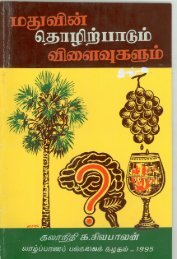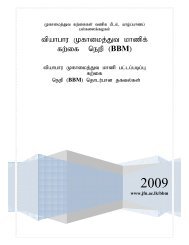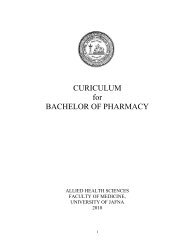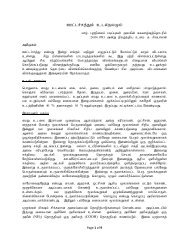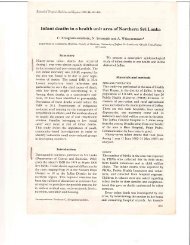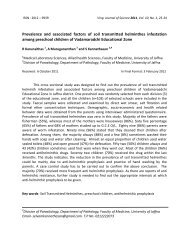MANUAL PHYSIOLOGY PRACTICAL - Repository:The Medical ...
MANUAL PHYSIOLOGY PRACTICAL - Repository:The Medical ...
MANUAL PHYSIOLOGY PRACTICAL - Repository:The Medical ...
Create successful ePaper yourself
Turn your PDF publications into a flip-book with our unique Google optimized e-Paper software.
FM/UOJ<br />
Experiment R1<br />
GRAPHIC RECORDING OF RESPIRATION<br />
<strong>The</strong> circumference of the chest increases during inspiration and decreases during<br />
expiration. This principle is used to record and study the qualitative aspects of respiratory<br />
movements.<br />
Instrument:<br />
Stethograph<br />
Method:<br />
Check the system for leaks first; adjust the recording pen to write on the<br />
kymograph drum; blow through the system to increase the pressure slightly so that the<br />
pen rises about 2 cm and clamp the opening; rotate the drum to draw a line of about 2 cm;<br />
and leave the system undisturbed for 2 minutes. If there is any leak the pen will drop<br />
down.<br />
Apply the stethograph to the chest of the subject snugly and adjust the pressure in<br />
the system to give a deflection of about 2.5 cm with each normal breath. Record the chest<br />
movements while the subject performs the following procedures.<br />
1. <strong>The</strong> subject breathes quietly at rest.<br />
2. <strong>The</strong> subject takes a deep breath and holds the breath until the breaking point is<br />
reached. Keep recording until the breathing comes back normal pattern.<br />
3. <strong>The</strong> subject breaths pure oxygen and holds breath at the end of normal inspiration<br />
until breaking point is reached. Keep recording until respiration comes back<br />
normal pattern.<br />
4. <strong>The</strong> subject breathes as fast and deep as possible. <strong>The</strong> subject relaxes when it<br />
becomes impossible to breath any more. Keep recording until the respiration<br />
comes back to normal.<br />
5. Allow the subject to relax and connect one-meter long tube to the mouth piece<br />
with the nose closed. Remove the tube when a steady state of breathing is reached<br />
and record until the breathing comes back to normal pattern after removing the<br />
tube.<br />
6. <strong>The</strong> subject coughs and sneezes violently.<br />
Respiration<br />
Page | 57



